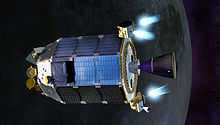(7888) 1993 UC
| Discovery[1] | |
|---|---|
| Discovered by | Robert H. McNaught |
| Discovery date | October 28, 1989 |
| Designations | |
| none | |
| Apollo NEO[1] | |
| Orbital characteristics[1] | |
|
Epoch 2013-Apr-18 (Uncertainty=0)[1] | |
| Aphelion | 4.0531 AU |
| Perihelion | 0.81793 AU |
| 2.4355 AU AU | |
| Eccentricity | 0.66416 |
|
3.80 yr (1,388 d) | |
| 15.158° (M) | |
| Inclination | 26.071° |
| 165.95° | |
| 323.00° | |
| Physical characteristics | |
| Dimensions | ~2.7 km (1.7 mi)[2] |
| ~1.3 m/s (3 mph) | |
| 2.340 h[1] | |
Spectral type | U |
| 14.1 (2013 peak)[3] | |
| 15.3[1] | |
|
| |
(7888) 1993 UC is a near-Earth minor planet in the Apollo group.[1] It was discovered by Robert H. McNaught at the Siding Spring Observatory in Coonabarabran, New South Wales, Australia, on October 20, 1993.[1] The asteroid has an observation arc of 23 years and has a well determined orbit.[1] Its estimated size is 2.3 to 5.2 km.[4]
On March 20, 2013, the asteroid passed 49 lunar distances or 0.12598 AU (18,846,000 km; 11,711,000 mi) from Earth at a relative velocity of 21.8 km/s (49,000 mph).[1] The approach posed no threat to Earth. (7888) 1993 UC is not classified as a potentially hazardous asteroid (PHA) because its Earth MOID (Minimum Orbit Intersection Distance) is only 0.089 AU,[1] and only objects with an Earth MOID less than 0.05 AU are considered PHAs.[5]
It was discovered to be a binary asteroid by Arecibo Observatory in March 2013.[6]
On April 29, 2146, the asteroid will pass 0.0346 AU (5,180,000 km; 3,220,000 mi) from asteroid 4 Vesta.[1]
See also
References
- ↑ 1.0 1.1 1.2 1.3 1.4 1.5 1.6 1.7 1.8 1.9 1.10 1.11 "JPL Close-Approach Data: 7888 (1993 UC)". Retrieved 2013-03-19.
2012-11-25 last obs (arc=23 years)
- ↑ (E.A.R.N.) physical data for (7888) 1993UC
- ↑ "1993 UC Ephemerides for 20 March 2013". NEODyS (Near Earth Objects – Dynamic Site). Retrieved 2013-03-19.
- ↑ NASA "NEO Earth Close Approach Tables", Retrieved on 21 December 2012.
- ↑ NASA/JPL "NEO Program FAQ", Retrieved on 21 December 2012.
- ↑ Dr. Lance A. M. Benner (2013-11-18). "Binary and Ternary near-Earth Asteroids detected by radar". NASA/JPL Asteroid Radar Research. Retrieved 2014-03-01.
| ||||||
| ||||||||||||||||||||||||||||
| |||||||||||||||||||||||||||||||||||||||||||
